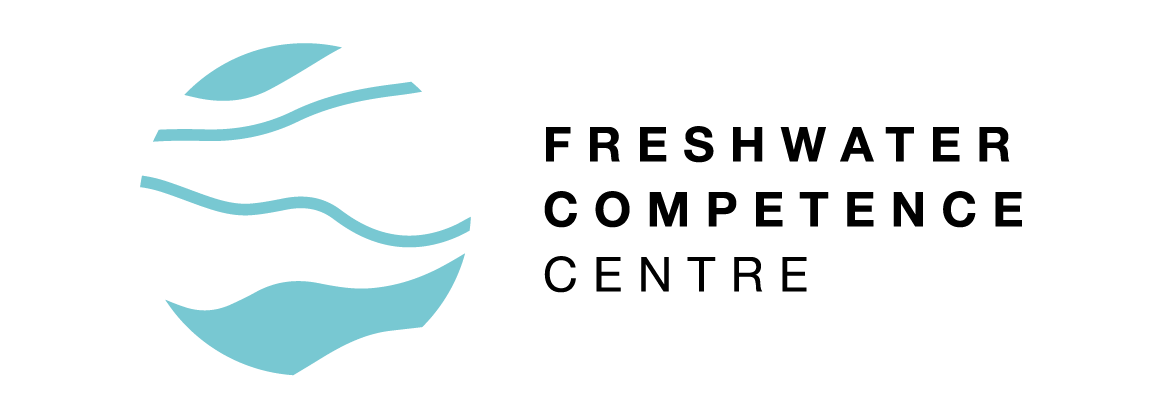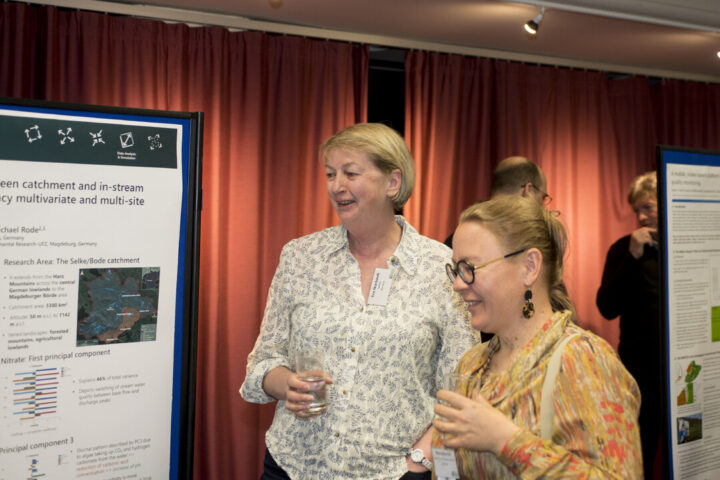Freshwater Competence Centre discussed Finnish Water Quality Monitoring & analysis and gypsum application to agricultural lands in Aberdeen, Scotland
In mid-June our partner organization Syke and researcher Maria Kämäri took part in the High Temporal Resolution Water Quality Monitoring and Analysis Workshop organized in Aberdeen, Scotland, with 66 participants from 17 different countries. The event was hosted by James Hutton Institute, which is an independent scientific research organization based in Scotland. The event was co-led with Swedish University of Agricultural Sciences SLU, University of Stirling and Hydro Nation International Centre.
Article image: Maria Kämäri & Eva Skarbøvik, NIBIO, Norway, looking at Eva’s poster on”Sensors for stakeholders?” from NORDBALT ECOSAFE: Nitrogen and phosphorus load reduction approach within safe ecological boundaries for the Nordic Baltic region – Nibio, where Syke is also a partner. Photo credit: Paul Glendell
Text: Annukka Pekkarinen & Maria Kämäri
From Freshwater Competence Centre, the workshop was participated by Maria Kämäri from Finnish Environment Institute Syke. Maria and her team manage the Pitkäkoski permanent monitoring station at our Supersite in Vantaanjoki, which is a large river running through the most urbanized areas in the capital region of Finland, and Maria’s presentation focused on long-term high-frequency monitoring in the Vantaanjoki River basin. “The trend analysis of 13 years of hourly timeseries data showed increasing trends in runoff and significantly decreasing trends in nitrate-nitrogen concentrations. The data also indicated that the application of gypsum (CaSO4 ∙ 2H2O) to agricultural fields had reduced soil erosion from fields.” Maria explains.
The aim is to apply gypsum, as a water protection measure, on 100 000 ha of fields. By now over 50 000 ha of fields have been amended with gypsum in the coastal areas of Finland since 2020. The sensors in the Vantaa River catchment enable us to study the gypsum effects in the catchment scale. The Vantaa River monitoring sites indicate that when the catchment field-% is large and a large share of the fields is treated with gypsum the positive water quality effects become evident. A long term continuous in situ monitoring enable us hopefully to detect decreasing trends in suspended solids and particulate phosphorus loads in the future.

Vantaanjoki is one of the main research focuses in the Freshwater Competence Centre
Maria became interested in the River Vantaanjoki during her PhD study in 2017. She was fascinated by the research related to the hysteresis effect, which is visible when combining high-frequency water quality and quantity data . “The hysteresis method paper by Charlotte Lloyd hess-20-625-2016.pdf (copernicus.org) was highly inspiring”, Maria tells. At that time Maria’s colleagues in Syke had been maintaining the high-frequency sensors in the Vantaanjoki River for several years and they offered the data for the PhD study. “Soon I booked me flight to Bristol and went to meet Charlotte. We made my first research paper about the Vantaanjoki River together.”
The Vantaanjoki river has been monitored for a long time as it is an important water resource for the capital region. The continuous monitoring station with the modern equipment was started 13 years ago, to measure turbidity, nitrogen and organic carbon. Some of the original sensors are still working.
With the Hydro RI platform infrastructure project funded by the European Union – NextGenerationEU, the site has been updated with a new spectrophotometer and fluorometer. The benefits of such sensors are that the measurements can be taken even hourly – the temporal resolution is therefore greatly increased compared to taking bi-weekly water samples. Physical water samples carried to the lab still have value with all the latest sensors: there are more parameters that can be studied from a physical water sample, but the benefits of having constant sampling almost in real-time are considerable.
Latest parameter that is measured and studied is tryptophan – Tryptophan is present in fresh organic matter, for example in waste water or naturally decomposing organic matter in the autumn time. If the quality of the tryptophan measurements can be studied so that the results are reliable, tryptophan could act as an indicator for microbial content of the water.
What was the outcome of the workshop?
Take away messages were many from a two-day long workshop showing e.g. advanced methods to analyse and understand the measured data and detect outliers. There is a need commonly define best practices of defining metadata related to sensor timeseries. New monitoring instruments and some special monitoring methods were also presented. Maria tells that there was several inspiring ideas: “It was interesting how the safety of drinking water quality in Netherlands is assured with biomonitoring by following the behavior of mussels. And did you know that cross-reactive nanoplasmonic sensor made from gold are capable of identifying and classifying complex liquid mixtures like coke or whisky!”
She continues: “The conference was for me a great opportunity to meet many enthusiast researchers that use high-frequency environmental monitoring data in their work. The workshop brough together senior scientists, PhD students and company representatives together to plan next steps in the field of fresh water sciences. I also enjoyed the beautiful environment around the Institute, the dinner was fantastic. Unfortunately, I was not able to join the field trip as I had to rush to the mid-summer celebration back home, but there was short outings arranged even during lunch breaks to see the nearby nature. I am looking forward collaboration within joint research projects in the future.”

Workshop programme:
HMRW Workshop – Key information (crew.ac.uk)
Related publications:
Kasvi Elina, Saarinen Aino, Kämäri Maria, Porkka Jutta, Alho Petteri, Ekholm Petri, The effect of seasonal variation, flow conditions and erosion forces on suspended matter fluxes from boreal gypsum-treated agricultural fields, CATENA, Volume 243, 2024,
https://doi.org/10.1016/j.catena.2024.108199.



